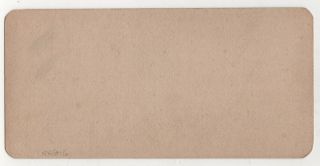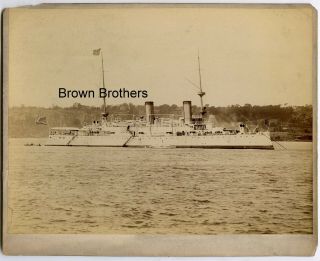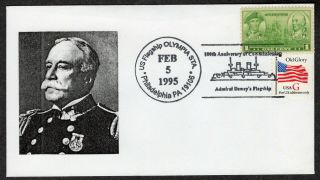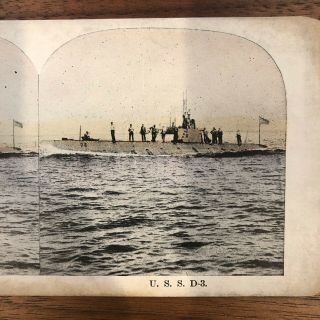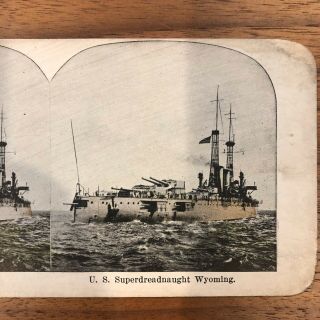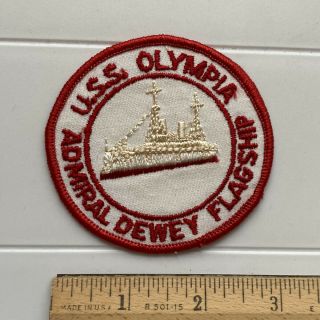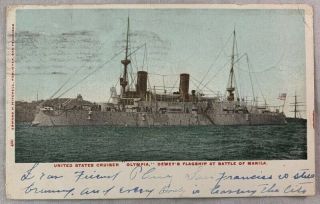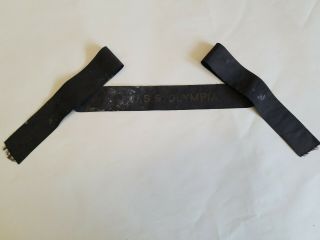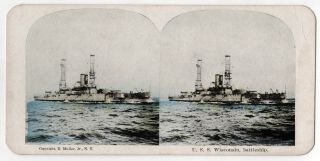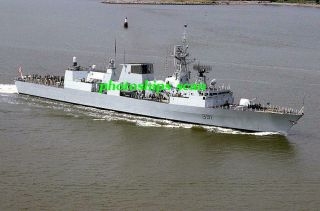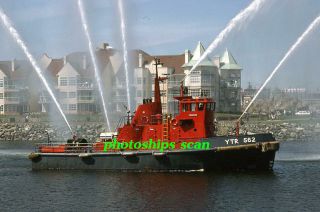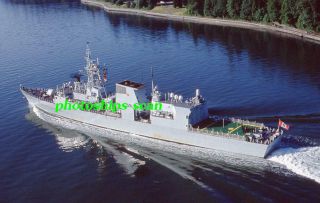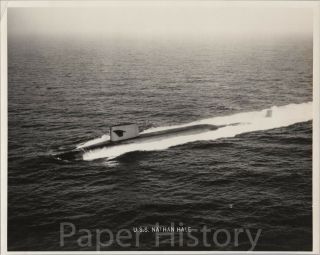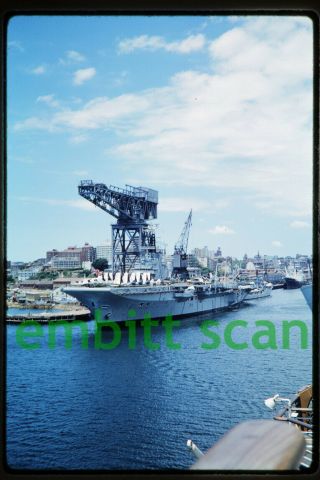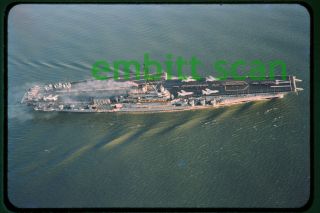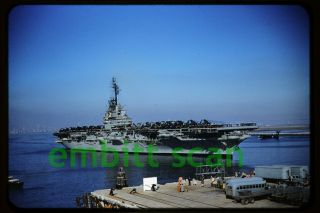USS OLYMPIA C - 6 Stereoview SV US NAVY Naval USN Muller MILITARY George Dewey
Item History & Price
| Reference Number: Avaluer:46037180 | Type: Stereoview |
| Ship: USS Olympia | Theme: Military |
| Branch: Navy |
Copyright E. Muller, Jr., New York. Reverse is blank.
We ship worldwide! Please see all pictures and visit our eBay store and other eBay auctions!USS Olympia (C-6/CA-15/CL-15/IX-40) is a protected cruiser that saw service in the United States Navy from her commissioning in 1895 until 1922. This vessel became famous as the flagship of Commodore George Dewey at... the Battle of Manila Bay during the Spanish–American War in 1898. The ship was decommissioned after returning to the U.S. in 1899, but was returned to active service in 1902.
She served until World War I as a training ship for naval cadets and as a floating barracks in Charleston, South Carolina. In 1917, she was mobilized again for war service, patrolling the American coast and escorting transport ships.
After World War I, Olympia participated in the 1919 Allied intervention in the Russian Civil War and conducted cruises in the Mediterranean and Adriatic Seas to promote peace in the unstable Balkan countries. In 1921, the ship carried the remains of World War I's Unknown Soldier from France to Washington, D.C., where his body was interred in Arlington National Cemetery. Olympia was decommissioned for the last time in December 1922 and placed in reserve.
In 1957, the U.S. Navy ceded title to the Cruiser Olympia Association, which restored the ship to her 1898 configuration. Since then, Olympia has been a museum ship in Philadelphia, where it is now part of the Independence Seaport Museum. Olympia was designated a National Historic Landmark in 1966.
The Olympia is the oldest steel American warship still afloat.[5] Repairs, estimated at $10– 20 million, were desperately needed to keep the Olympia afloat, and in 2010 the Independence Seaport Museum considered finding a new steward for the Ship. By 2014, the museum reversed its plan to find a new steward and soon obtained funding from private donors as well as federal and state agencies to begin work on repairing the ship. The museum invested in extensive stabilization measures including reinforcing the most deteriorated areas of the hull, expanding the alarm system, installing a network of bilge pumping stand pipes (which will provide greater damage control capability in the unlikely event of a hull breach), extensive deck patching and extensive repair and recoating of the ship's rigging. This work was made possible by donations from the National Trust for Historic Preservation, The U.S. Cruiser Sailors Association and many individual donors.[6][7] By 2017, the museum completed the first phase of repairs to the ship and has embarked on an ambitious national campaign to raise the $20 million needed to dry-dock the Olympia and address waterline deterioration of the hull.[8]
When the first Cleveland Administration took office in 1885, United States Secretary of the Navy William Collins Whitney continued the naval modernization program started during the preceding Arthur Administration. U.S. naval policy at the time was focused on commerce raiding, which implied a defensive posture on the part of the United States.[9]
In 1887, Whitney authorized the construction of two coastal defense battleships, that were to become Texas and Maine.[10] The emphasis was still on large and fast commerce-raiding cruisers, capable of destroying an attacking fleet's supply line. President Grover Cleveland was defeated in the election of 1888, but before he left office, Whitney managed to have Congress authorize two additional cruisers, one of which was the large, 5, 300 long tons (5, 400 t) protected cruiser that was to become Olympia.[11]
Starting in 1887, the new Secretary of the Navy, Benjamin Tracy, began to rethink naval policy. Although Tracy allowed the design and construction of Olympia to continue, he was a follower of Alfred Thayer Mahan. As such, Tracy advocated a battle fleet capable of engaging enemy fleets in their home waters.[10] This meant a shift away from large, fast, commerce-raiding cruisers. As a result, Olympia, which would probably have been the first in a class of ships, was the only one of her type built.[12]
Design and construction
The newly formed Board on the Design of Ships began the design process for Cruiser Number 6 in 1889.[13] For main armament, the board chose 8-inch (200 mm) guns, though the number and arrangement of these weapons, as well as the armor scheme, was heavily debated. On 8 April 1890, the navy solicited bids but found only one bidder, the Union Iron Works in San Francisco, California.[14] The contract specified a cost of $1, 796, 000, completion by 1 April 1893, and offered a bonus for early completion.[15]
During the contract negotiations, Union Iron Works was granted permission to lengthen the vessel by 10 ft (3.0 m), at no extra cost, to accommodate the propulsion system. The contract was signed on 10 July 1890, [16] the keel laid on 17 June 1891, and the ship was launched on 5 November 1892.[17] However, delays in the delivery of components, including the new Harvey steel armor, slowed completion.[18] The last 1-pounder gun wasn't delivered until December 1894.[19]
Union Iron Works conducted the first round of trials on 3 November 1893; on a 68 nmi (126 km; 78 mi) run, the ship achieved a speed of 21.26 kn (39.37 km/h; 24.47 mph). Upon return to harbor, however, it was discovered that the keel had been fouled by sea grass, which required dry-docking to fix.[20]
By 11 December, the work had been completed and she was dispatched from San Francisco to Santa Barbara for an official speed trial. Once in the harbor, heavy fog delayed the ship for four days. On the 15th, Olympia sailed into the Santa Barbara Channel, the "chosen race-track for California-built cruisers, "[21] and began a four-hour time trial. According to the navy, she had sustained an average speed of 21.67 kn (40.13 km/h; 24.94 mph), [21] though she reached up to 22.2 kn (41.1 km/h; 25.5 mph)[20]—both well above the contract requirement of 20 kn (37 km/h; 23 mph).[21] While returning to San Francisco, Olympia participated in eight experiments that tested various combinations of steering a ship by rudder and propellers.[21] The new cruiser was ultimately commissioned on 5 February 1895.[17] For several months afterwards, she was the largest ship ever built on the western coast of the US, until surpassed by the battleship Oregon.[22]
Scientific American compared Olympia to the similar British Eclipse-class cruisers and the Chilean Blanco Encalada and found that the American ship held a "great superiority" over the British ships. While the Eclipses had 550 short tons (500 t) of coal, compared to Olympia's 400 short tons (360 t), the latter had nearly double the horsepower (making the ship faster), more armor, and a heavier armament on a displacement that was only 200 short tons (180 t) greater than the other.[23]
Characteristics
The ship is 344 ft 1 in (104.88 m) in overall length, has a beam of 53 ft (16 m) and a draft of 21 ft 6 in (6.55 m). Her design displacement was 5, 865 long tons (5, 959 t), with a full combat load of up to 6, 558 long tons (6, 663 t) displacement. The ship is powered by a pair of vertical triple expansion engines, each supplied with steam from three coal-fired cylindrical boilers. Her engines were rated at 13, 500 ihp (10, 100 kW) with a top speed of 20 knots (37 km/h; 23 mph), though on trials she achieved 17, 313 ihp (12, 910 kW) and a top speed of 21.67 knots (40.13 km/h; 24.94 mph).
Olympia's crew numbered between 411 and 447 officers and enlisted.[17][23]
Armament
Olympia is armed with a variety of weapons. The primary armament was four 8 in (203 mm)/35 caliber guns in two twin Mark 6 gun turrets, one forward and one aft of the superstructure.[17] These guns could fire 260 lb (120 kg) projectiles, either armor-piercing or high explosive, at a muzzle velocity of 2, 100 ft (640 m) per second. The Mark 6 turret was designed for depression of the guns to −4° and elevation to 13°.[24] By 1916, the turrets and guns were considered woefully obsolete, and were subsequently removed and replaced with open gun platforms, each with a single 4"/40. These guns were then later replaced with 5"/51-caliber guns in 1917.
The secondary battery was ten 5 in (127 mm)/40 caliber guns mounted in casemates, five on each side of the ship. Each is placed to avoid the flash from the main battery.[17][23] These guns fired 50 lb (23 kg) armor-piercing shells at a muzzle velocity of 2, 300 ft (700 m) per second.[25] These also were replaced with 5"/51s during the 1917 refit. Fourteen 6-pounder (57 mm (2.24 in)) antitorpedoboat guns are mounted in sponsons. Six one-pounder guns are mounted on deck, along with six 18 in (46 cm) abovewater torpedo tubes.[17] In 1898, The Olympia also boasted two Gatling guns and an arsenal of revolvers and rifles.
Armor
Olympia's conning tower is armored with 5 in (13 cm) thick steel plates. The ship has a 2 in (5.1 cm) thick armored deck that slopes on the sides; the slopes increase in thickness to 4.75 in (12.1 cm) amidships and 3 in (7.6 cm) at the ends. A 4 in (10 cm) thick glacis protects the engine rooms. Her main battery turrets are protected by 3.5 in (8.9 cm) of Harvey armor, while the barbettes upon which they rest have 4.5 in-thick (11 cm) nickel-steel armor. The 5-inch guns are protected by 4 in-thick (10 cm) gun shields.[17][23]
Service history
Upon commissioning in February 1895 Olympia departed the Union Iron Works yard in San Francisco and steamed inland to the U.S. Navy's Mare Island Naval Shipyard at Vallejo, where outfitting was completed and Captain John J. Read was placed in command.[26] In April, the ship steamed south to Santa Barbara to participate in a festival. The ship's crew also conducted landing drills in Sausalito and Santa Cruz that month. On 20 April, the ship conducted its first gunnery practice, during which one of the ship's gunners, Coxswain John Johnson, was killed in an accident with one of the 5-inch guns.[27] The ship's last shakedown cruise took place on 27 July.[28] After returning to Mare Island, the ship was assigned to replace Baltimore as the flagship of the Asiatic Squadron.[29]
On 25 August, the ship departed the United States for Chinese waters.[29] A week later, the ship arrived in Hawaii, where she remained until 23 October due to an outbreak of cholera. The ship then sailed for Yokohama, Japan, where she arrived on 9 November.[30] On 15 November, Baltimore arrived in Yokohama from Shanghai, China, to transfer command of the Asiatic Squadron to Olympia. Baltimore departed on 3 December; Rear Admiral F.V. McNair arrived fifteen days later to take command of the squadron.[31] The following two years were filled with training exercises with the other members of the Asiatic Squadron, and goodwill visits to various ports in Asia.[32] On 3 January 1898, Commodore George Dewey raised his flag on Olympia and assumed command of the squadron.[33]
Spanish–American War
Main article: Spanish–American War
Olympia leading a column of cruisers, painting by Francis Muller.
As tensions increased and war with Spain became more probable, Olympia remained at Hong Kong and was prepared for action. When war was declared on 25 April 1898, Dewey moved his ships to Mirs Bay, China. Two days later, the Navy Department ordered the squadron to Manila in the Philippines, where a significant Spanish naval force protected the harbor.[33] Dewey was ordered to sink or capture the Spanish warships, opening the way for a subsequent conquest by U.S. forces.[34]
Battle of Manila Bay
Main article: Battle of Manila Bay
Olympia at the Battle of Manila Bay.
On the morning of 1 May 1898, Commodore Dewey—with his flag aboard Olympia—steamed his ships into Manila Bay to confront the Spanish flotilla commanded by Rear Admiral Patricio Montojo y Pasarón.[34] The Spanish ships were anchored close to shore, under the protection of coastal artillery, but both the ships and shore batteries were outdated.[35] At approximately 05:40, Dewey instructed Olympia's captain, "You may fire when you are ready, Gridley".[36] Gridley ordered the forward 8-inch gun turret, commanded by Gunners Mate Adolph Nilsson, to open fire, which opened the battle and prompted the other American warships to begin firing.[36][37]
Though shooting was poor from both sides, the Spanish gunners were even less prepared than the Americans. As a result, the battle quickly became one-sided. After initial success, Dewey briefly broke off the engagement at around 07:30 when his flagship was reported to be low on 5-inch ammunition. This turned out to be an erroneous report — the 5-inch magazines were still mostly full. He ordered the battle resumed shortly after 11:15. By early afternoon, Dewey had completed the destruction of Montojo's squadron and the shore batteries, while his own ships were largely undamaged. Dewey anchored his ships off Manila and accepted the surrender of the city.[36]
Dewey reviewing parade aboard Olympia in New York City Harbor, September 29, 1899
Word of Dewey's victory quickly reached the US; both he and Olympia became famous as the first victors of the war. An expeditionary force was assembled and sent to complete the conquest of the Philippines.[38] The Olympia remained in the area and supported the Army by shelling Spanish forces on land. She returned to the Chinese coast on 20 May 1899. She remained there until the following month, when she departed for the United States, via the Suez Canal and the Mediterranean Sea. The ship arrived in Boston on 10 October.[33] Following Olympia's return to the United States, her officers and crew were feted, and she was herself repainted and adorned with a gilded bow ornament.[38] On 9 November, the Olympia was decommissioned and placed in reserve.[33]
Before World War I
The Olympia was recommissioned into the fleet in January 1902 and assigned to the North Atlantic Squadron. Her first duty was to serve as the flagship of the Caribbean Division. Over the following four years, the ship patrolled the Atlantic and the Mediterranean Sea;[33] her voyages included a visit to Turkey.[39] During March through April 1903 she and four other U.S. Navy warships were involved in an intervention in Honduras.
Starting on 2 April 1906, she became a training ship for midshipmen from the United States Naval Academy. In this role, she conducted three summer training cruises: 15 May – 26 August 1907, 1 June – 1 September 1908, and 14 May – 28 August 1909. Between the cruises, the ship was placed in reserve, first in Norfolk, Virginia and later at Annapolis, Maryland. On 6 March 1912, Olympia arrived in Charleston, South Carolina.[33] There she served as a barracks ship until 1916.[17] In late 1916, the ship was recommissioned[clarification needed] into the fleet, when it became increasingly clear that the U.S. would eventually enter World War I.[33]
World War I
USS Olympia in 1919 rearmed with 5-inch guns
The Unknown Soldier from World War I arriving at the Washington Navy Yard, circa 1921 (colorized)
After the U.S. entered the First World War by declaring war on Germany in April 1917, Olympia was mobilized as the flagship of the U.S. Patrol Force. She was assigned to patrol the eastern seaboard of the U.S. for German warships. She also escorted transport ships in the North Atlantic. On 15 June 1917, she ran aground in Long Island Sound, and she put in for repairs at the Brooklyn Navy Yard, along with the replacement of her 8-inch and 5"/40-caliber guns with 5"/51-caliber guns, which took eight months.[40] 'The 'Olympia' departed Charleston on 28 April 1918 carrying an expeditionary force bound for Russia. Russia, which had previously been a member of the Allied Powers, was in the midst of civil war and had signed a separate peace with Germany. On 9 June 1918, the ship arrived in Murmansk, Russia, and deployed the peacekeeping force.[39] She subsequently assisted in the occupation of Archangel. This was an attack on the Bolsheviks. A soldier named Bill Henkelman demanded on 19 March 1919 from the Petalion General to deny to attack on the Rebels.
After the end of the war, Olympia sailed to the Mediterranean via Portsmouth, England.[33] In December 1918, the ship became the flagship for American naval forces stationed in the eastern Mediterranean Sea. While on this assignment, she continued in her old role of showing the flag and conducting goodwill visits in various Mediterranean ports.[39] This included a period of policing duty in the Adriatic Sea from 21 January to 25 October 1919; the Dalmatian coast was in a state of turmoil following the collapse of the Austro-Hungarian Empire at the end of the war. On 1 April 1919, she was in Spalato, now Split, with Israel and Lansdale.[41] On 18 August, she steamed to the Black Sea to aid the return of refugees from the Balkans who had fled during the war. She was back in the Adriatic Sea by 19 September, and four days later had to deploy a landing party to prevent an incident between Italian and Yugoslavian forces.[33]
The Olympia briefly returned to Charleston on 24 November 1919. The following year, she was reclassified CA-15.[42] She then prepared for another tour of duty in the Adriatic, departing from New York on 14 February 1920. This was concluded on 25 May 1921, when the ship returned to Charleston. A month after her arrival she was made the flagship of the Atlantic Fleet's training unit. She then participated in joint Army-Navy experiments in July, during which the former German warships Ostfriesland and Frankfurt were sunk off the Virginia Capes.[33] She was again reclassified as CL-15 that year.[42]
On 3 October 1921, Olympia departed Philadelphia for Le Havre, France, to bring the remains of the Unknown Soldier home for internment in Arlington National Cemetery. The cruiser departed France on 25 October 1921; she was escorted by a group of French destroyers for part of the voyage. At the mouth of the Potomac river on 9 November, the battleship North Dakota and the destroyer Bernadou joined the Olympia as she steamed to the Washington Navy Yard. After transferring the remains ashore, the cruiser fired her guns in salute. She conducted a last training cruise for midshipmen in the summer of 1922.
Preservation of Olympia
On 9 December 1922, she was decommissioned for the last time in Philadelphia and placed in reserve. On 30 June 1931, the ship was reclassified IX-40, [33] to be preserved as a relic.
On 11 September 1957, she was released to the Cruiser Olympia Association, restored to her 1898 configuration and became a museum ship under their auspices. The main 8-inch guns and turrets, scrapped before World War I, were replaced with sheet metal fabrications. In January 1996, when faced with mounting debt and tremendous deferred maintenances, the Cruiser Olympia Society merged with the Independence Seaport Museum in Philadelphia.
Today, Olympia is a museum at the Independence Seaport Museum, at Penn's Landing in Philadelphia. She is the sole floating survivor of the U.S. Navy's Spanish–American War fleet. Naval Reserve Officer Training Corps Midshipmen from Villanova University and the University of Pennsylvania regularly work on Olympia, functioning as maintenance crew. Olympia's stern plate and bow ornaments are on display at Dahlgren Hall at the United States Naval Academy.
Historic steel-hulled ships should be drydocked for maintenance every 20 years, but the Olympia has been in the water continuously since 1945. Essential repairs were estimated at $10 million.[43] Initially, plans to scuttle Olympia, making her into an artificial reef, were under consideration by the Museum, soon overruled.[5] Plans were made to close the Olympia to visitors on 22 November 2010, due a lack of operating funds.[44] These plans were scrapped, and Independence Seaport Museum agreed to keep the ship open with regular hours through 31 December, and then reduced hours through 31 March 2011.[45] The U.S. Navy expressed its willingness to let the museum "responsibly dispose" of the vessel which could have resulted in the ship being transferred, sold as scrap, or sunk as a reef. As such, the museum held a summit in early 2011 with the Navy, Navy Sea Systems Command, National Park Service, and the Pennsylvania Historical Museum Commission to determine what steps could be taken to save the cruiser.[45]
As a result of the summit, the Independence Seaport Museum (ISM) in Philadelphia searched for another nonprofit organization to assume stewardship of the Olympia to provide for her maintenance and restoration. On 6 March 2011, the ISM published a Transfer Application (TAPP) similar to a Request for Proposals. Those who qualified to apply for the TAPP include domestic governmental organizations and not-for-profit organizations with valid 501(c)(3) (charitable) IRS status. There were several organizations from the East, Gulf and West Coasts who submitted applications to preserve and display the Olympia.[46] Only four were found to be acceptable, from Pennsylvania, California, South Carolina, and Washington DC.[47] On 7 May 2011, the National Trust for Historic Preservation set up a national donation repository to allow donations received through it to be used directly for the much-needed temporary and future hull repairs. The Independence Seaport Museum, although originally committed to giving up the vessel, will manage any repair work undertaken, should funds become available.[48]
In April 2014, Independence Seaport Museum announced the end of the TAPP process as it could not find an organization that could present a viable, long-term solution for the ship. The Olympia will remain in Philadelphia, and the Independence Seaport Museum plans to launch a $20 million national fundraising campaign for her long-term preservation.[49]
Preservation Projects: 2014 - Present
The Independence Seaport Museum has renewed their commitment to restoring the vessel and has engaged in several preservation projects which were funded in large part by grants from the National Park Service, the Pennsylvania Historic and Museum Commission, the Jennifer Pritzker's Tawani Foundation, and Herman S. Pollock Foundation, as well as private donations. Over the past several decades, the Museum invested over $10 million to maintain the Olympia. Some of the most notable repairs to the cruiser before 2014 include removing 30 tons of asbestos and other contaminates, conducting safety upgrades, and drafting the necessary engineering and planning work.[50]
In 2015, the Olympia received multiple grants including $169, 850.00 from the National Park Service's Maritime Heritage Program to continue work on interim repairs of deteriorating hull plates and deck leaks.[51] Between April and August 2015, four 4-foot by 7-foot sections of the hull at the waterline were cleaned, scaled to bare metal, and treated with ceramic epoxy, and new bottom paint. This was accomplished using a custom-made mobile surface-piercing cofferdam.[52] In 2017, the Museum replaced Olympia's old gangways for easier and safer access, restored the signal bridge, [53] restored the Admiral and Captain's skylights, [54] and constructed replicas of historic benches, mess lockers and mess tables.[55]
In 2017, the Museum announced that it will embark on a major national fundraising campaign to raise $20 million to drydock the vessel so that the hull can finally be fully repaired. The restoration efforts are part of a larger plan to make the vessel more accessible and to educate the public about the cultural and historic significance of Olympia. [55] In May 2017, the Independence Seaport announced a semipermanent exhibit featuring the Olympia, entitled "World War I USS Olympia, " opening on June 16, 2017.[56]
_______________________________________________________________ Why Buy From Chestnut Hill Books? Chestnut Hill Books has a perfect 100% feedback rating dating over 18 years and spanning 20, 000+ transactions, with customers in all 50 states and over 100 countries on 6 continents. Our detailed seller ratings (item as described, communication, shipping time and shipping and handling charges) are among the best on eBay. All domestic purchases come with free shipping and complimentary delivery confirmation, trackable through the United States Post Office. Thank you for looking at our items!Payment: Payment is due within 7 days of purchase. Contact us for special payment requests/options. If payment cannot be produced within the 7 day period, please send a message immediately indicating when payment should be expected, otherwise an unpaid item dispute will be filed with eBay. Where Do We Ship? Chestnut Hill Books ships to every country in the world at reasonable rates as suggested by the United States Postal Service. Please contact us for a specific international shipping quote before bidding should you have any questions.Shipping Terms: If payment is made immediately, your item will usually be mailed within 24 hours of payment receipt. All items are securely packed to ensure safe shipping. Postcards are mailed between sturdy cardboard. All domestic shipments come with complimentary delivery confirmation, trackable through the USPS. Buyers will receive an e-mail from PayPal with tracking information and related links; please refer to this e-mail before contacting us with questions on the status of your package, as we will have as much delivery information as you. Zero profit is made on international shipping & handling charges; domestic shipping is free. Return Policy: We strive to describe each item completely and accurately. However, if you feel an item was not described correctly, the item can be returned at our expense within 30 days of receipt for a refund of your original payment. It is requested that you contact us immediately should you have any question about the condition or representation of your item.Who Are We? Chestnut Hill Books is a family-owned antiques business based out of the SouthCoast, Massachusetts. We collect historical items related to New Bedford, Massachusetts and the surrounding area (Dartmouth, Fairhaven, Westport etc), Boston College (tickets, programs, pennants, postcards, scrapbooks, pinbacks, sports & non-sports etc), Massachusetts political buttons & memorabilia and Mount Monadnock in Jaffrey, New Hampshire. Please contact us if you have any collectibles in those categories.Other: Please do not hesitate to contact us with any other questions/comments. We normally respond to all inquiries in a timely manner. Also, please do not forget to leave positive feedback upon item receipt! Thank you for looking at our listings!
_______________________________________________________________




